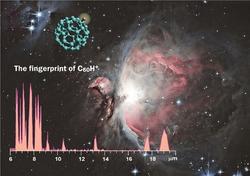Buckyballs in space – The IR spectrum of protonated buckminsterfullerene C60H+
Although fullerenes have long been hypothesized to occur in interstellar environments, their actual unambiguous spectroscopic identification is of more recent date.FELIX researchers have recorded the first laboratory infrared spectrum of gaseous C60H+.
C60, C70 and C60+ now constitute the largest molecular species individually identified in the interstellar medium (ISM). Fullerenes have significant proton affinities and it was Sir Harold Kroto who suggested that C60H+ is likely the most abundant interstellar analogue of C60.
FELIX researchers have recorded the first laboratory infrared (IR) spectrum of gaseous C60H+. The added proton breaks the high symmetry of C60 producing a much richer IR spectrum, forming a textbook example of the influence of molecular symmetry on IR spectroscopy. The experimental spectrum is used to benchmark theoretical spectra indicating that the B3LYP density functional with the 6-311+G(d,p) basis set reproduces the spectrum most closely. Moreover, and perhaps most interesting, comparison with astronomical spectra from two planetary nebulae that have been associated with high abundances of neutral C60 indicate that C60H+ is a plausible contributor to their IR emission, possibly confirming Kroto’s hypothesis.
Read the publication

